Kalevala bone setting
| Kalevala bone setting | ||||
|---|---|---|---|---|
| In the national inventory | ||||
|
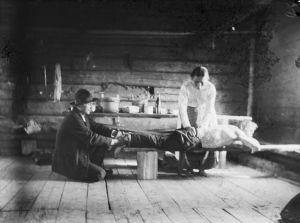
Practitioners and people who know the tradition well
In traditional healing culture, health is seen as a comprehensive entity that comprises functional structures, nutrition and the mind. Traditional Kalevala healing methods, such as Kalevala bone setting, are a centuries old method of softly handling the body’s tissues by utilising the ranges of motion of the joints in such a way that the body is restored to its natural state, in which defences are not needed. As a traditional healing method, Kalevala bone setting upholds a culture of working with the hands, in which touch and interaction are important. The tradition is practised by roughly 800 trained ‘kalevalainen jäsenkorjaaja’ (Kalevala bonesetter), which is a title protected by the EU.
Kansanlääkintäseura ry (the Folk Medicine Society) organises training in fifteen municipalities around Finland in cooperation with community colleges, among others. The number of people trained in the skill increases by roughly a hundred every year. Founded in 1986, Kansanlääkintäseura ry records and shares knowledge of the folk medicine tradition, which includes Kalevala bone setting. The society has over 1,400 members.
Kalevalainen kansanparannus -säätiö (the Kalevala Folk Medicine Foundation), which was founded in 2014, records and shares knowledge of traditional healing more widely with the help of seminars, bulletins, position statements and publications. In 2015, the foundation set up Perinnehoitojen neuvottelukunta (the Advisory Committee for Traditional Healing) to support the recording of traditional healing methods and interaction with government agencies and members of Parliament. The aim of the advisory committee is to establish a national traditional medicine strategy for Finland in accordance with the goals of the World Health Organization (WHO) and promote research into Kalevala bone setting as well as better awareness of the practice.
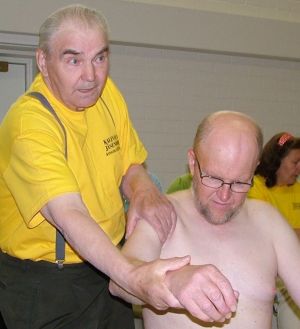
Practising of the tradition
Kalevala bone setting is based on respectful handling of the soft tissue throughout the body. Tissue structures are opened with slow movements by utilising the fluids in the connective tissue and by taking the flow of lymph into account. The joints are adjusted into place by utilising the customer’s voluntary ranges of motion. This opens up the nutrient circulation and restores the function of the nerves to its natural state, in which defences are not needed. This healing method was brought up to date by master healer Olavi Mäkelä, together with Kansanlääkintäseura ry. Today, we understand the importance of venous valves, the lymphatic system and the interstitial fluid in loose connective tissue, which is emphasised in the respectful handling of tissue practised in Kalevala bone setting. Other things that are linked to body stiffness and the terminology related to it include the innervation and three-dimensionality of membranes and the movement of membranes in relation to each other. Kalevala bone setting is a comprehensive traditional healing method that is used to treat musculoskeletal disorders and the ailments caused by them, for example.
Kansanlääkintäseura ry trains experts through a practice-oriented, three-year, multiform training programme. During those three years, the experts must carry out no fewer than 300 documented treatments. During the first year of study, the students learn how to treat misalignment through muscles and joints. During their second year, they learn how to utilise the interstitial fluid in loose connective tissue in opening up membranes. During their third year, they learn the importance of innervation. Before the right to use the title Kalevala bonesetter is granted, the individual has to pass a competence demonstration. The right to use the job title requires adherence to the code of ethics and participation in continuing education at least every other year. In this continuing education, the students study the treatment of customers with an increasing number of issues according to the tradition. The training is divided into the titles of apprentice, journeyman, Kalevala bonesetter and master.
Students are driven to apply for the training on account of their own interest in the tradition and their personal therapeutic experience. Experts who are suited for providing training share their knowledge with new students, and masters assess competence demonstrations. There are roughly 800 experts living around Finland. A few experts live in European countries such as Sweden, Denmark, Spain and Portugal. There are no different schools of Kalevala bone setting, but Finland does have other types of joint manipulation traditions.
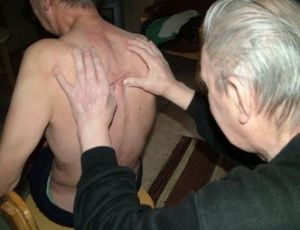
The background and history of the tradition
In the old days, the bone setting tradition was taught within the family with the apprenticeship method, and the skills were passed on from one family member to another.
Master Mauri Hartea gathered knowhow related to massaging from the Nordic countries and Northern Europe and established the Finnish massaging method and the first school for massage therapists at the beginning of the 20th century. According to his teachings, tissue had to be respected and handled softly, without causing pain, and the massaging always had to be carried out towards the heart. Kalevala bone setting is based on soft and painless handling of tissue in accordance with Mauri Hartea’s teachings.
In 1996, Kansanlääkintäseura ry named this form of treatment Kalevala bone setting after the treatment traditions mentioned above, and this name was registered as a protected name with the EU’s Office for Harmonization in the Internal Market in 2005. The status of a protected name allows Kalevala bone setting to be distinguished from joint manipulation methods that are based on manipulation and/or different types of massage, in order to provide consumer protection. Over the last ten years, more information has been gained on the structures of loose connective tissue and the innervation of membranes. Today, we have a better understanding of the therapeutic effect of Kalevala bone setting and the traditional knowhow related to the method.
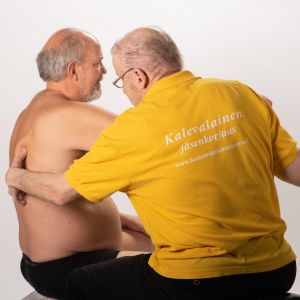
The transmission of the tradition
The citizens’ positive experiences of Kalevala bone setting have increased awareness of this healing method in Finland and also, to some extent, abroad. This increase in awareness has been contributed to by the personal experience of more than a hundred thousand customers annually, or the experience of a friend or relative, of how misalignment of the body has affected pain and the individual’s quality of life. Awareness has increased in the traditional way, by word of mouth.
The expertise related to the Kalevala bone setting tradition is also spread with the help of a practice-oriented, three-year training programme. Information about it travels through the citizens’ network formed by customers and with the help of communications. In the 2010s, Kalevala bone setting has been carried out more than three million times. Since the late 2010s, more than ten thousand brochures have been distributed at trade fairs and various events per year.
Kalevala bone setting has been examined more extensively in Perinnehoitojen verhottu tieto (Veiled Knowledge of Traditional Healing, Vertanen, Hänninen, Piippo, Piilo & Tuohimaa, 2017), a book written about traditional healing by experts who have recorded traditional healing methods and who are well-versed in them. Regional lectures have also been held. For example, 54 lectures were held in 2017 and 2018, and they reached over 5,000 listeners.
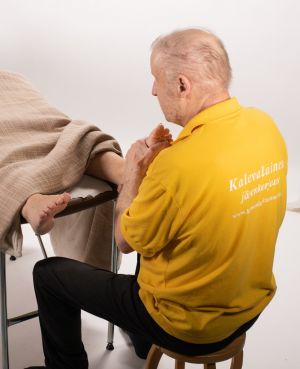
Kalevala bone setting has also been examined in interactive hour-long radio broadcasts on Järviradio, in which citizens have called in to the broadcast and shared their experiences and asked questions about Kalevala bone setting. Additionally, Yleisradio, AlfaTV and magazines have shared information about Kalevala bone setting.
The future of the tradition
The future of the Kalevala bone setting tradition looks strong, thanks to the active and interactive network of experts and users. The traditional healing culture of Kalevala bone setting is upheld among users of traditional healing methods, who understand its importance. Therapeutic experiences support the upholding of this healing tradition. In Finland, the official societal attitudes towards traditional healing culture do not correspond to the experience of customers and the appreciation that they have for Kalevala bone setting. In the future, the experiences of users can be shared with the general public in more detail by documenting them. The practitioners of the tradition hope that the appreciation of the authorities towards the culture of healing with the hands will be increased. They also hope that the significance of therapeutic effect, touch and interaction in Kalevala bone setting, which is part of traditional healing culture, will be highlighted more in the future.
The community/communities behind this submission
Kalevalainen kansanparannus -säätiö
Perinnehoitojen neuvottelukunta.
Päiviö Vertanen, chairsman, Kalevalainen kansanparannus -säätiö.
Bibliography and links to external sources of information
Websources
Yle Uutiset: Jäsenkorjaaja palauttaa kehon luonnolliseen tilaan 5.8.2013
Yle Uutiset: Kalevalaisesta jäsenkorjauksesta apua migreeniin 20.10.2010
Yle Akuutti: Kalevalainen Jäsenkorjaus 19.3.2018
Päivänlehti: Kalevalaisella jäsenkorjauksella selkä kuntoon... 20.5.2017
Videos
Yle Areena: Kotimaan kasvot kalevalainen kansanparannus 15.11.2016
YouTube: Perinnehoitojen merkitys seminaari Tiedekeskus Heurekassa 28.2.2019; Hieronta ja kuppaus
Järviradio: TULES-seminaari Tiedekeskus Heureka 16.9.2019
Radio programs
Yle Areena: Kalevalainen Jäsenkorjaus ja kuppaus 29.3.2019
Yle Areena: Perttu Häkkinen: kansanlääkintää ja kalevalaista jäsenkorjausta 23.5.2017
Yle Areena: Liikuntatunti: Kalevalainen jäsenkorjaaja löytää vanhankin vaivan 5.12.2013
Järviradio: Kalevalainen Jäsenkorjaus terveydenhoidossa ohjelmasarja ja AlfaTV
Literature and another references
Kalevalaisen jäsenkorjauksen tunnettavuuskysely, Anna Markkula Jyväskylän yliopisto, 2019
Perinnehoitojen tietoisuuden lisääminen 2017-2018, Eveliina Rajala, Itä-Suomen yliopisto 2019,Kalevalaisen jäsenkorjauksen osaajakysely, Eveliina Rajala, 2019
Vertanen, Päiviö & Hänninen, Osmo & Piippo, Sinikka & Tuohimaa, Pentti & Piilo, Riitta (2017) Perinnehoitojen verhottu tieto. Kokkola: Kalevalainen kansanparannus-säätiö.
